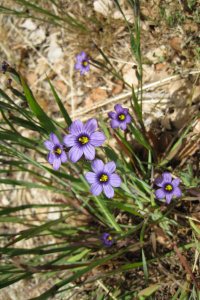Sisyrinchium bellum is in the Iris family. Species in this family are distinct in the flowers having three stamens and six tepals (a general term for both the petals and sepals) made up of an inner and an outer whorl. Despite its common name and the “grassy” look of this species, it is not a grass.
Photo Credit: © Dvortygirl via Wikimedia Commons
Sisyrinchium bellum
Common Name: western blue-eyed grass
Plant Functional Group: Forb
Class > Order > Family: Magnoliopsida > Asparagales > Iridaceae
What does the species look like?
Stems of this perennial species grow from a rhizome and can be as long as 60 cm with long slender “grass-like” leaves. The flowers are 1 to 2 centimeters in diameter, and are purplish blue or occasionally white. They have three petals and three sepals which join at the base forming a tube with a yellow center. After flowering, it dies back to the ground and goes dormant for the summer.Sisyrinchium bellum i s found in grassy areas, chaparral, coastal sage scrub and woodlands, at elevations less than 2400 meters.
Where is the species found?
States & Provinces
CA, OR
Which phenophases should I observe?
Do you see...?
Leaves
Initial growth More...
Leaves More...
Flowers
Flowers or flower buds More...
How many flowers and flower buds are present? For species in which individual flowers are clustered in flower heads, spikes or catkins (inflorescences), simply estimate the number of flower heads, spikes or catkins and not the number of individual flowers.
Less than 3 3 to 10 11 to 100 101 to 1,000 More than 1,000
Open flowers More...
What percentage of all fresh flowers (buds plus unopened plus open) on the plant are open? For species in which individual flowers are clustered in flower heads, spikes or catkins (inflorescences), estimate the percentage of all individual flowers that are open.
Less than 5% 5-24% 25-49% 50-74% 75-94% 95% or more
Fruits
Fruits Sisyrinchium bellum , the fruit is a capsule that changes from green to tan or dark brown and splits open to expose the seeds. Do not include empty capsules that have already dropped all of their seeds.More...
How many fruits are present?
Less than 3 3 to 10 11 to 100 101 to 1,000 More than 1,000
Ripe fruits Sisyrinchium bellum , a fruit is considered ripe when it has turned tan or dark brown and has split open to expose the seeds. Do not include empty capsules that have already dropped all of their seeds.More...
What percentage of all fruits (unripe plus ripe) on the plant are ripe?
Less than 5% 5-24% 25-49% 50-74% 75-94% 95% or more
Recent fruit or seed drop More...
How many mature fruits have dropped seeds or have completely dropped or been removed from the plant since your last visit?
Less than 3 3 to 10 11 to 100 101 to 1,000 More than 1,000
What do these phenophases look like?
There is currently no photoguide available for this species. If you'd like help us create one, use the guidance document and species template provided here . Then send it via email to education@usanpn.org when it is complete.
